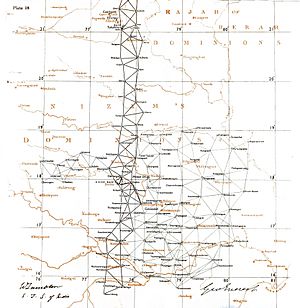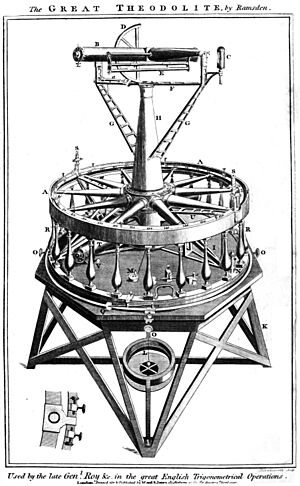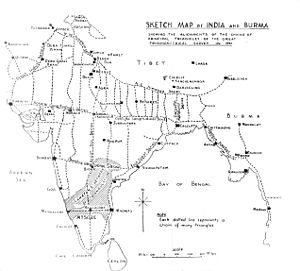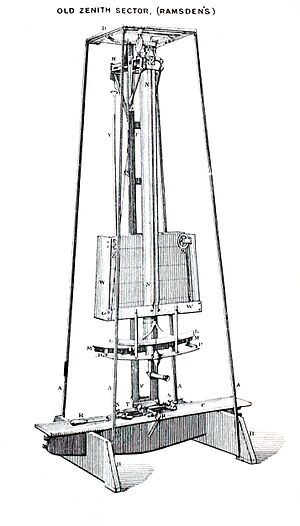William Lambton facts for kids
Quick facts for kids
William Lambton
|
|
|---|---|

Lambton in 1822, oil painting by William Havell in the Royal Asiatic Society
|
|
| Born | 1753 Crosby Grange
|
| Died | January 1823 (aged 70) Hinganghat
|
| Nationality | British |
| Occupation | Engineer, surveyor |
| Known for | Founding Superintendent of the Great Trigonometric Survey |
| Signature | |
Lieutenant-Colonel William Lambton (around 1753 – January 1823) was a British soldier and surveyor. He started a huge land measurement project in India in 1800. This project became known as the Great Trigonometrical Survey of India.
Lambton's first goal was to measure a specific part of the Earth. This helped scientists understand the Earth's shape better. He also planned a large survey across India. He worked on these surveys for over twenty years. William Lambton passed away while working in central India. His assistant, George Everest, took over his important work.
Contents
Life of a Great Surveyor
Early Years
William Lambton was born around 1753 in Crosby Grange, England. His family were farmers. He didn't share much about his early life. People guess his birth year from a story he told. In 1803, he said he was fifty years old at a dinner in India.
William came from a humble background. He sent a lot of his pay home to support his parents. He was very good at math. This skill helped him get into a grammar school in Northallerton. He studied under a famous teacher, Dr. Charles Hutton.
Military Career and New Skills
In 1781, Lambton joined the army as an ensign. He later moved to the 33rd Regiment of Foot. His talent for surveying was soon noticed. He started working on measuring land for new settlers in America.
He fought in the American War of Independence. During the Siege of Yorktown, he was captured. He accidentally hurt his eye while looking at a solar eclipse. After this, he got a job as a barrack-master in New Brunswick. This job gave him time to study math on his own. He later became a barrack-master in Nova Scotia. He said this time helped him gain knowledge that would make him famous.
In 1795, he rejoined his regiment in Calcutta, India. The 33rd Regiment was led by Sir Arthur Wellesley.
Surveying in India

In 1796, Lambton was promoted to Lieutenant. He went to India with his regiment. He took part in the Fourth Anglo-Mysore War in 1799. He showed great skill in guiding his troops using the stars. He even prevented a big mistake during a night march.
After the capture of Mysore, Lambton had an idea. He suggested surveying the land using new methods. These methods were like those used in Great Britain. His idea was almost rejected by Major James Rennell. But Nevil Maskelyne, a top astronomer, supported Lambton's plan. Maskelyne saw the scientific value of the survey.
Lambton heard about special instruments being returned from China. These tools included a zenith sector (a telescope for measuring angles) and a Ramsden chain. He got these instruments in 1801.
The Great Trigonometrical Survey Begins
The official survey began in 1802. Lambton started by measuring a baseline near Madras. This was a very precise measurement of a long distance. Then, he used triangulation to measure distances. This involves creating a network of triangles. By measuring angles and one side, you can figure out all other sides.
He extended the survey west to Mangalore. Then he moved north from Bangalore. He also surveyed south to Cape Comorin. Lambton continued his work northwards until he died. He passed away in Hinganghat in January 1823. A memorial was built for him there.
Lambton had children in India. One of his sons, also named William Lambton, later joined the Survey in 1815.
How the Surveys Were Done
Lambton's survey was officially named the Great Trigonometrical Survey in 1818. He followed a system used in England for similar surveys. His main goal was to measure a part of the Earth's curve. This helped to understand the exact shape of the Earth.
Lambton wanted to make very exact measurements. He used special tools like the Ramsden's chain. This chain was designed to account for temperature changes. He also used a "boning telescope" to align survey poles.
The main tool for his primary measurements was a Great Theodolite. This huge instrument weighed about half a ton. It needed twelve men to carry it! Lambton measured all three angles of his triangles. This helped him check for accuracy. When he compared his calculated measurements with a baseline in Bangalore, they were very close. The difference was only about 3.5 inches.
Honours and Legacy
William Lambton received several important honours. He became a Fellow of the Royal Society in 1817. He also became a member of the French Academy of Sciences.
A narrow ridge in India is named after him: Lambton's Peak Range. In 2003, a special bust (a statue of his head and shoulders) was placed in Chennai, India, to remember his work.





